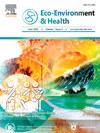水稻启动子pLsi1驱动的PvACR3表达促进水稻土中砷的植物提取
IF 17.6
引用次数: 0
摘要
水稻土砷污染是一个全球性问题,严重威胁着水稻生产和食品安全。超蓄积体植物因其从污染土壤中去除污染物的潜力而受到广泛关注。然而,目前还没有发现天然的超蓄积体来修复洪水条件下砷污染的水稻土。利用基因工程技术使水稻超富集砷,对水稻土进行有效的植物修复是一种很有前景的策略。一个关键的挑战仍然是在不影响耐受性的情况下增加金属积累。本研究在水稻根特异性启动子pLsi1的控制下,引入砷超积累植物Pteris vittata的PvACR3,培育出高砷积累和耐砷的转基因修复水稻。在20 μM NaAsO2水培处理下,修复水稻株茎部砷浓度达到451 ~ 557 mg/kg,在中度砷污染水稻土盆栽处理下,修复水稻株茎部砷浓度达到45.9 ~ 80.3 mg/kg。与野生型水稻相比,pLsi1::PvACR3转基因水稻从相同的水稻土壤中去除的砷是野生型水稻的23.5倍。灌浆前采收水稻苗,土壤孔隙水As几乎完全枯竭,As的酸溶性和可还原性组分显著降低。本研究首次提出了具有高砷积累、耐受性和对水涝条件下水稻土适应性的转基因修复水稻,可进行有效的植物修复。本文章由计算机程序翻译,如有差异,请以英文原文为准。

Promoter pLsi1 driven PvACR3 expression in rice enhances arsenic phytoextraction in paddy soils
Arsenic (As) contamination in paddy soils is a global problem, threatening rice production and food safety. Hyperaccumulator plants have garnered significant attention for their potential to remove pollutants from contaminated soil. However, no natural hyperaccumulators have been found for the phytoremediation of As-contaminated paddy soils under flooding conditions. One promising strategy is to genetically engineer Oryza sativa (rice) to hyperaccumulate As for effective phytoremediation of paddy soil. A key challenge remains in increasing metal accumulation without compromising tolerance. Here, PvACR3 from the As hyperaccumulator Pteris vittata was introduced under the control of a rice root-specific promoter pLsi1 to create high-As-accumulating and tolerant transgenic remediation rice. The remediation rice strains exhibited robust growth, with shoot As concentration reaching up to 451–557 mg/kg in a hydroponic experiment with 20 μM NaAsO2 treatment, and 45.9–80.3 mg/kg in pot experiments with moderately As-contaminated paddy soils. Compared to wild-type rice, the pLsi1::PvACR3 transgenic rice removed 23.5 times more As from the same paddy soils. By harvesting rice shoots before grain filling, the soil pore water As was almost completely depleted, and the acid-soluble and reducible fractions of As were significantly reduced. This study presents the first transgenic remediation rice characterized by high As accumulation, tolerance, and adaptability to paddy soils under flooding conditions for effective phytoremediation.
求助全文
通过发布文献求助,成功后即可免费获取论文全文。
去求助
来源期刊

Eco-Environment & Health
环境科学与生态学-生态、环境与健康
CiteScore
11.00
自引率
0.00%
发文量
18
审稿时长
22 days
期刊介绍:
Eco-Environment & Health (EEH) is an international and multidisciplinary peer-reviewed journal designed for publications on the frontiers of the ecology, environment and health as well as their related disciplines. EEH focuses on the concept of “One Health” to promote green and sustainable development, dealing with the interactions among ecology, environment and health, and the underlying mechanisms and interventions. Our mission is to be one of the most important flagship journals in the field of environmental health.
Scopes
EEH covers a variety of research areas, including but not limited to ecology and biodiversity conservation, environmental behaviors and bioprocesses of emerging contaminants, human exposure and health effects, and evaluation, management and regulation of environmental risks. The key topics of EEH include:
1) Ecology and Biodiversity Conservation
Biodiversity
Ecological restoration
Ecological safety
Protected area
2) Environmental and Biological Fate of Emerging Contaminants
Environmental behaviors
Environmental processes
Environmental microbiology
3) Human Exposure and Health Effects
Environmental toxicology
Environmental epidemiology
Environmental health risk
Food safety
4) Evaluation, Management and Regulation of Environmental Risks
Chemical safety
Environmental policy
Health policy
Health economics
Environmental remediation
 求助内容:
求助内容: 应助结果提醒方式:
应助结果提醒方式:


